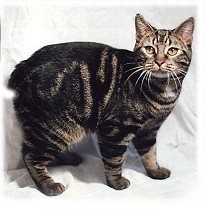This article includes a list of general references, but it lacks sufficient corresponding inline citations .(March 2008) |
Cats, like all living organisms, occasionally have mutations that affect their body type. Sometimes, these mutations are striking enough that humans select for and perpetuate them. However, in relatively small or isolated feral cat populations the mutations can also spread without human intervention, for example on islands. Cat breeders exploit the naturally occurring mutations by selectively breeding them in a small gene pool, resulting in the creation of new cat breeds with unusual physical characteristics. [1] The term designer cat is often used to refer to these cat breeds. [1] This is not always in the best interests of the cat, as many of these mutations are harmful; some are even lethal in their homozygous form. To protect the animal's welfare it is illegal in several countries or states to breed with parent cats that bear certain of these hypertype mutations.
Contents
- Tail types
- Dwarfism
- Paws
- Ear types
- Hairlessness
- Miniature-sized
- Breeding ethics and ban of designer cats
- References
- Further reading
This article gives a selection of cat body type mutant alleles and the associated mutations with a brief description.






